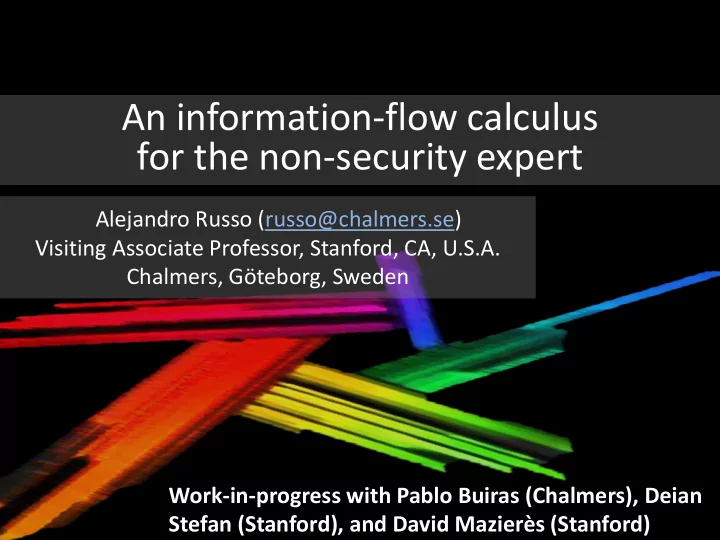

An information-flow calculus for the non-security expert Alejandro Russo (russo@chalmers.se) Visiting Associate Professor, Stanford, CA, U.S.A. Chalmers, Göteborg, Sweden Work-in-progress with Pablo Buiras (Chalmers), Deian Stefan (Stanford), and David Mazierès (Stanford)
Information-flow Scenario Preserve confidentiality even in the presence of malicious code
Motivation
Security measures • Access control – State-of-the-art
Security lattice • It specifies the allowed flows of information secret public
Example of Rules Arrows for Secure Information Flow [Li, Zdancewic 10]
Information-flow Scenario
Towards a Monadic Calculus Reader Monad - The attacker might observe the systems data Writer Monad - The attacker writes input to the system Informatoin-flow control is almost just about controling reading and writing side-effects
Towards a Monadic Calculus Security State (floating label) Restricted interface for the State monad!
A Floating Label System [Stefan et al. 11] Taint Guard
Example of Rules Arrows for Secure Information Flow [Li, Zdancewic 10] Guard
Example of Rules Information-Flow Security for a Core of JavaScript [Hedin, Sabelfeld 12] Taint
Designing IFC Systems Read effect Write effect newIORef readIORef writeIORef modifyIORef Read effect Write effect Guard newLIORef Taint readLIORef Guard writeLIORef Taint Guard modifyLIORef
The IFC Monad [Swierstra 08] data ReadEffect l a where Taint :: l -> a -> ReadEffect l a data WriteEffect l a where Guard :: l -> a -> WriteEffect l a Free (ReadEffect l) a Free (WriteEffect l) a IFC l a = Free (WriteEffect l :+: ReadEffect l) a Types reflects the behavior w.r.t taint and guard!
Label Creep [Stefan et al. 11][Breeze 13] • The floating label gets too high too soon!
Label Creep [Stefan et al. 11][Breeze 13] • The floating label gets too high too soon! Fresh environment
A specific Local (Reader Monad) data Env l a where Ask :: (l -> a) -> Env l a Put :: l -> Env l a Extended IFC l a = Free (WriteEffect l :+: ReadEffect l :+: Env l) a local :: forall l. Label l => IFC l () -> IFC l () local m = do (s :: l) <- IFC.ask m IFC.put s return ()
Is it General Enough? LIO IFC LB-Monitors
Final Remarks • IFC = controlling reading and writing side-effects + a notion of scope (local) type IFC l a = Free (ReadEffect l :+: WriteEffect l :+: Env l) a • A non-security expert can have a good impression of the security checks (taint/guard) • Floating label systems seems to be more convenient than traditional LB-monitors
Interested in Details? https://github.com/alejandrorusso/ifc-wg2.8.git
Recommend
More recommend